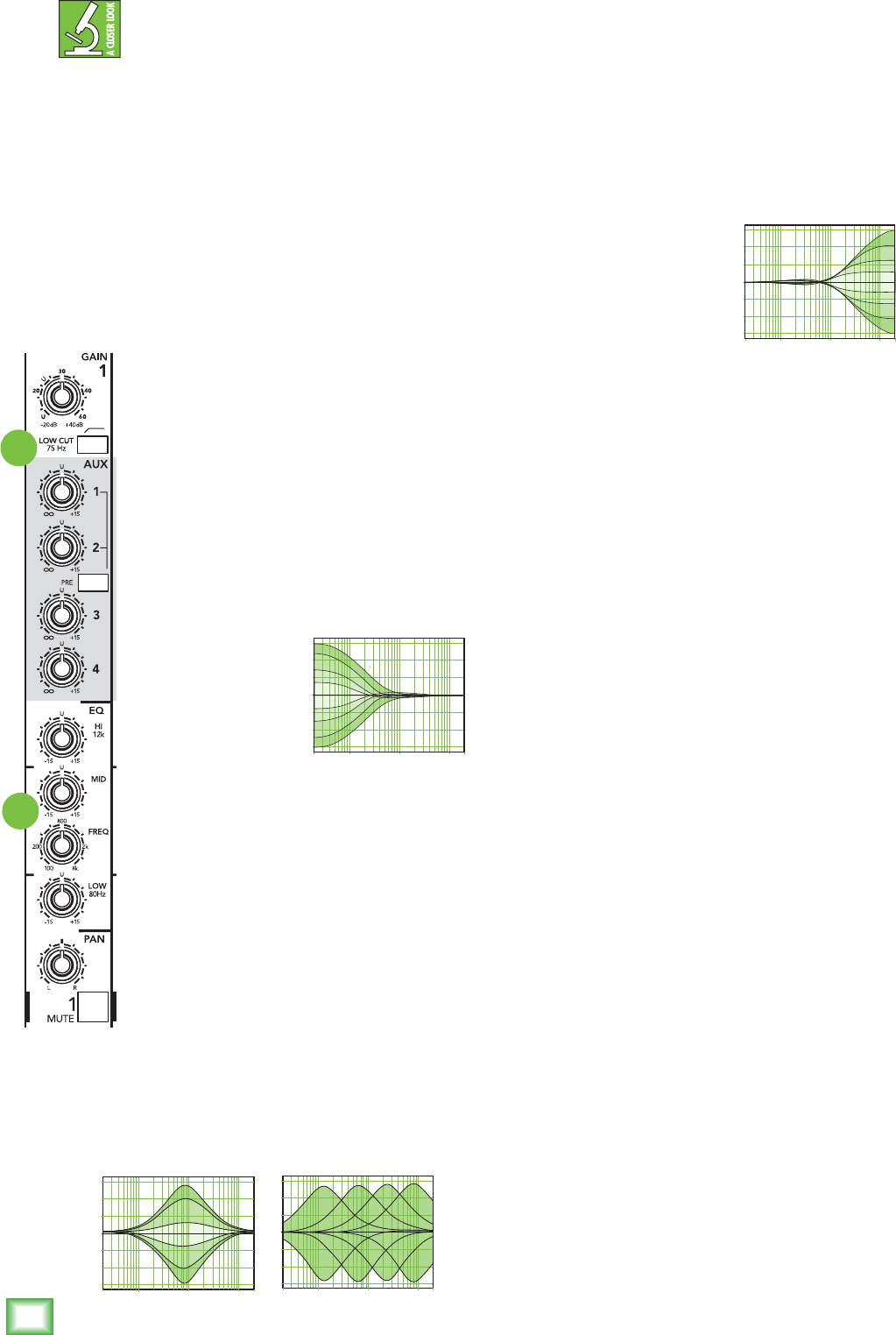
16
1642VLZ4
1642VLZ4
Constant Loudness ! ! !
The1642VLZ4’spancontrolsemployadesign
called“ConstantLoudness.”Ithasnothingto
dowithlivingnexttoafreeway.Asyouturn
thepanknobfromlefttoright(therebycausingthe
soundtomovefromthelefttothecentertotheright),
thesoundwillappeartoremainatthesamevolume
(orloudness).
Ifyouhaveachannelpannedhardleft(orright)and
reading0dB,itmustdipdownabout4dBontheleft
(orright)whenpannedcenter.Todootherwise,like
thoseBrandXmixers,wouldmakethesoundappear
muchlouderwhenpannedcenter.
32. 3-Band Mid-Sweep EQ
Theeightmonochannelshavea3-band,
mid-sweepequalization:lowshelvingat80
Hz,midsweeppeakingfrom100Hzto8kHz,
andhishelvingat12kHz.It’sprobablyallthe
EQyou’lleverneed!(Shelvingmeansthatthe
circuitryboostsorcutsallfrequenciespast
thespeciedfrequency.Forexample,the
1642VLZ4’slowEQboostsbassfrequencies
below80Hzandcontinuingdowntothe
lowestnoteyouneverheard.Peakingmeans
thatcertainfrequenciesforma“hill”around
thecenterfrequency.)
ThelowEQ
providesupto15dB
boost or cut below
80Hz.Thecircuitis
at(noboost
orcut)atthecenter
detentposition.Thisfrequency
representsthepunchinbassdrums,bass
guitar,fatsynthpatches,andsomereally
seriousmalesingerswhoeatbrokenglassfor
breakfast.
Usedinconjunctionwiththelowcut[34]
switch,youcanboostthelowEQwithout
injectingatonofsubsonicdebrisintothe
mix.Werecommendusingthelowcutfeature
onallchannels,exceptlowfrequencysignals,
likekickdrumsandbassguitars.
ThemidEQ,or“midrange,”hasaxedbandwidthof
1octave.Themidknobsetstheamountofboostorcut,
upto15dB,andiseffectivelybypassedatthecenter
detent.Thefrequencyknobsetsthecenterfrequency,
sweepablefrom100Hzto8kHz.
32
34
20
Hz
100
Hz
1k
Hz
10k
Hz
20k
Hz
–15
–10
–5
0
+5
+10
+15
20
Hz
100
Hz
1k
Hz
10k
Hz
20k
Hz
–15
–10
–5
0
+5
+10
+15
20
Hz
100
Hz
1k
Hz
10k
Hz
20k
Hz
–15
–10
–5
0
+5
+10
+15
Mostoftherootandlowerharmonicsthatdenea
soundarelocatedinthe100Hz–8kHzfrequencyrange,
and you can create drastic changes with these two
knobs.ManyengineersusemidEQtocutmidrange
frequencies,notboostthem.Onepopulartrickisto
setthemidfullyup,turnthefrequencyknobuntil
youndapointwhereitsoundsjustterrible,then
backthemiddownintothecutrange,causingthose
terriblefrequenciestodisappear.Soundssilly,but
itworks.Sometimes.
ThehiEQprovidesyouup
to15dBboostorcutabove
12kHz,anditisalsoat
at the detent. Use it to add
sizzletocymbals,anoverall
senseoftransparency,oran
edgetokeyboards,vocals,
guitarandbaconfrying.Turnitdownalittletoreduce
sibilanceortomasktapehiss.
WithtoomuchEQ,youcanscrewthingsuproyally.
We’vedesignedalotofboostandcutintoeachequalizer
circuitbecauseweloveyou,andknowthateveryone
willoccasionallyneedthat.ButifyoumaxtheEQon
everychannel,you’llgetmixmush.Equalizesubtlyand
usetheleftsidesoftheknobs(cut),aswellastheright
(boost).Ifyoundyourselfrepeatedlyusingfullboost
orcut,consideralteringthesoundsource,such
asplacingamicdifferently,tryingadifferentkindof
mic,changingthestrings,orgargling.
33. 4-Band Fixed-Frequency EQ
Thestereochannels(9-16)havea4-band,
xed-frequencyequalization:lowshelvingat80Hz,
lowmidpeakingat400Hz,himidpeakingat2.5kHz,
andhishelvingat12kHz.
Eachoftheseltersprovidesupto15dBofboost
orcut.Aswiththemonochannels,thecircuitisat
(noboostorcut)atthecenterdetentpositions.
20
Hz
100
Hz
1k
Hz
10k
Hz
20k
Hz
–15
–10
–5
0
+5
+10
+15


















